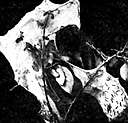web·worm
(wĕb′wûrm′)n.
Any of various usually destructive caterpillars that construct webs.
American Heritage® Dictionary of the English Language, Fifth Edition. Copyright © 2016 by Houghton Mifflin Harcourt Publishing Company. Published by Houghton Mifflin Harcourt Publishing Company. All rights reserved.
webworm
(ˈwɛbˌwɜːm)n
(Animals) US a moth species best known for its larval stage, when it spins a large web in which to eat or rest
Collins English Dictionary – Complete and Unabridged, 12th Edition 2014 © HarperCollins Publishers 1991, 1994, 1998, 2000, 2003, 2006, 2007, 2009, 2011, 2014
web•worm
(ˈwɛbˌwɜrm)n.
the larva of any of several moths, which spins a web over the foliage on which it feeds.
[1790–1800]
Random House Kernerman Webster's College Dictionary, © 2010 K Dictionaries Ltd. Copyright 2005, 1997, 1991 by Random House, Inc. All rights reserved.
ThesaurusAntonymsRelated WordsSynonymsLegend:
| Noun | 1. |  webworm - several gregarious moth larvae that spin webs over foliage on which they feed webworm - several gregarious moth larvae that spin webs over foliage on which they feedfamily Lasiocampidae, Lasiocampidae - tent caterpillars; eggars; lappet moths fall webworm, Hyphantria cunea - a variety of webworm garden webworm, Loxostege similalis - a variety of webworm caterpillar - a wormlike and often brightly colored and hairy or spiny larva of a butterfly or moth |
Based on WordNet 3.0, Farlex clipart collection. © 2003-2012 Princeton University, Farlex Inc.